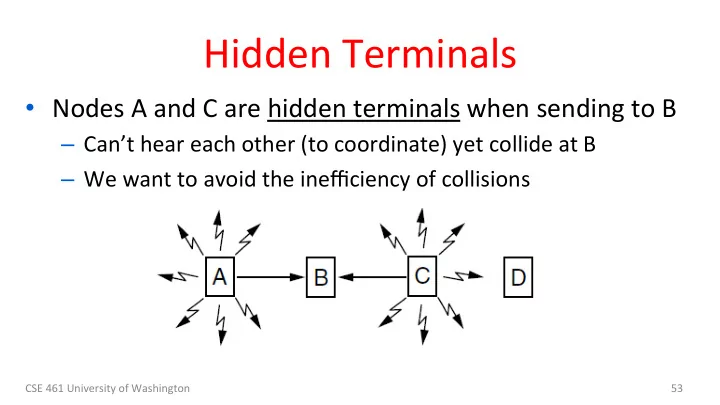

Hidden$Terminals$ • Nodes$A$and$C$are$hidden$terminals$when$sending$to$B$ – Can’t$hear$each$other$(to$coordinate)$yet$collide$at$B$ – We$want$to$avoid$the$inefficiency$of$collisions $ CSE$461$University$of$Washington$ 53$
Exposed$Terminals$ • B$and$C$are$exposed$terminals$when$sending$to$A$and$D$ – Can$hear$each$other$yet$don’t$collide$at$receivers$A$and$D$ – We$want$to$send$concurrently$to$increase$performance $ CSE$461$University$of$Washington$ 54$
Nodes$Can’t$Hear$While$Sending$ • With$wires,$detecFng$collisions$ (and$aborFng)$lowers$their$cost$ • More$wasted$Fme$with$wireless$ Wired$ Wireless$ Collision$ Collision$ Resend$ Resend$ X$ XXXXXXXXX$ X$ Time$ XXXXXXXXX$ CSE$461$University$of$Washington$ 55$
Possible$SoluFon:$MACA$ • MACA$uses$a$short$handshake$instead$of$CSMA$(Karn,$1990)$ – 802.11$uses$a$refinement$of$MACA$(later)$$ • Protocol$rules:$ 1. A$sender$node$transmits$a$RTS$(Request`To`Send,$with$frame$ length)$ 2. The$receiver$replies$with$a$CTS$(Clear`To`Send,$with$frame$length)$ 3. Sender$transmits$the$frame$while$nodes$hearing$the$CTS$stay$silent$ – Collisions$on$the$RTS/CTS$are$sFll$possible,$but$less$likely$ CSE$461$University$of$Washington$ 56$
MACA$–$Hidden$Terminals$ • A ! B$with$hidden$terminal$C$ 1. A$sends$RTS,$to$B$$ A B C D CSE$461$University$of$Washington$ 57$
MACA$–$Hidden$Terminals$(2)$ • A ! B$with$hidden$terminal$C$ 2. B$sends$CTS,$to$A,$and$C$too$$ RTS$ A B C D CSE$461$University$of$Washington$ 58$
MACA$–$Hidden$Terminals$(3)$ • A ! B$with$hidden$terminal$C$ 2. B$sends$CTS,$to$A,$and$C$too$$ Alert!$ RTS$ A B C D CTS$ CTS$ CSE$461$University$of$Washington$ 59$
MACA$–$Hidden$Terminals$(4)$ • A ! B$with$hidden$terminal$C$ 3. A$sends$frame$while$C$defers$ Quiet...$ Frame$ CSE$461$University$of$Washington$ 60$
MACA$–$Exposed$Terminals$ • B ! A,$C ! D$as$exposed$terminals$ – B$and$C$send$RTS$to$A$and$D$$ A B C D CSE$461$University$of$Washington$ 61$
MACA$–$Exposed$Terminals$(2)$ • B ! A,$C ! D$as$exposed$terminals$ – A$and$D$send$CTS$to$B$and$C$$ RTS$ RTS$ A B C D CSE$461$University$of$Washington$ 62$
MACA$–$Exposed$Terminals$(3)$ • B ! A,$C ! D$as$exposed$terminals$ – A$and$D$send$CTS$to$B$and$C$$ All$OK$ All$OK$ RTS$ RTS$ A B C D CTS$ CTS$ CSE$461$University$of$Washington$ 63$
MACA$–$Exposed$Terminals$(4)$ • B ! A,$C ! D$as$exposed$terminals$ – A$and$D$send$CTS$to$B$and$C$$ Frame$ Frame$ A B C D CSE$461$University$of$Washington$ 64$
802.11,$or$WiFi$ • Very$popular$wireless$LAN$ To$Network$ Access$ started$in$the$1990s$ Point$ • Clients$get$connecFvity$from$a$ (wired)$AP$(Access$Point)$ Client$ • It’s$a$mulF`access$problem$ " $$ • Various$flavors$have$been$ developed$over$Fme$ – Faster,$more$features$$ CSE$461$University$of$Washington$ 65$
802.11$Physical$Layer$ • Uses$20/40$MHz$channels$on$ISM$bands$ – 802.11b/g/n$on$2.4$GHz$ – 802.11$a/n$on$5$GHz$ • OFDM$modulaFon$(except$legacy$802.11b)$ – Different$amplitudes/phases$for$varying$SNRs$ – Rates$from$6$to$54$Mbps$$plus$error$correcFon$ – 802.11n$uses$mulFple$antennas;$see$“802.11$ with$MulFple$Antennas$for$Dummies”$ CSE$461$University$of$Washington$ 66$
802.11$CSMA/CA$for$MulFple$Access$ • Sender$avoids$collisions$by$inserFng$small$random$gaps$ – E.g.,$when$both$B$and$C$send,$C$picks$a$smaller$gap,$goes$first$ Send?$ Send?$ Time$ CSE$461$University$of$Washington$ 67$
The$Future$of$802.11$(Guess)$ • Likely$ubiquitous$for$Internet$connecFvity$ – Greater$diversity,$from$low`$to$high`end$devices$$ • InnovaFon$in$physical$layer$drives$speed$ – And$power`efficient$operaFon$too$ • More$seamless$integraFon$of$connecFvity$ – Too$manual$now,$and$limited$(e.g.,$device`to`device)$ CSE$461$University$of$Washington$ 68$
Issues$with$Random$MulFple$Access$ • CSMA$is$good$under$low$load:$ – Grants$immediate$access$ – Lible$overhead$(few$collisions)$ • But$not$so$good$under$high$load:$ – High$overhead$(expect$collisions)$ – Access$Fme$varies$(lucky/unlucky)$ • We$want$to$do$beber$under$load!$ CSE$461$University$of$Washington$ 69$
Turn`Taking$MulFple$Access$Protocols$ • They$define$an$order$in$which$ nodes$get$a$chance$to$send$ – Or$pass,$if$no$traffic$at$present$ • We$just$need$some$ordering$…$ – E.g.,$Token$Ring$ » $ – E.g.,$node$addresses$ CSE$461$University$of$Washington$ 70$
Token$Ring$ • Arrange$nodes$in$a$ring;$token$rotates$“permission$to$ send”$to$each$node$in$turn$ Toke Node$ n$ DirecFon$of$ transmission$ CSE$461$University$of$Washington$ 71$
Turn`Taking$Advantages$ • Fixed$overhead$with$no$collisions$ – More$efficient$under$load$ • Regular$chance$to$send$with$no$ unlucky$nodes$ – Predictable$service,$easily$extended$ to$guaranteed$quality$of$service$ CSE$461$University$of$Washington$ 72$
Turn`Taking$Disadvantages$ • Complexity$ – More$things$that$can$go$wrong$ than$random$access$protocols!$ • E.g.,$what$if$the$token$is$lost?$ – Higher$overhead$at$low$load$ CSE$461$University$of$Washington$ 73$
Turn`Taking$in$PracFce$ • Regularly$tried$as$an$improvement$ offering$beber$service$ – E.g.,$qualiFes$of$service$ • But$random$mulFple$access$is$$$ hard$to$beat$ – Simple,$and$usually$good$enough$ – Scales$from$few$to$many$nodes$ CSE$461$University$of$Washington$ 74$
Topic$ • How$do$we$connect$nodes$with$a$ switch$instead$of$mulFple$access$ – Uses$mulFple$links/wires$$ – Basis$of$modern$(switched)$Ethernet$ Switch$ CSE$461$University$of$Washington$ 75$
Switched$Ethernet$ • Hosts$are$wired$to$Ethernet$ switches$with$twisted$pair$ – Switch$serves$to$connect$the$hosts$ – Wires$usually$run$to$a$closet$ $ Switch$ Switch$ports$ Twisted$pair$ CSE$461$University$of$Washington$ 76$
What’s$in$the$box?$ • Remember$from$protocol$layers:$ Hub,$or$ Physical$Physical$ repeater$ All$look$like$this:$ Link$ Link$ Switch$ Network $ Network $ Router$ Link$ Link$ CSE$461$University$of$Washington$ 77$
Inside$a$Hub$ • All$ports$are$wired$together;$more$convenient$and$ reliable$than$a$single$shared$wire$ ↔$ CSE$461$University$of$Washington$ 78$
Inside$a$Switch$ • Uses$frame$addresses$to$connect$input$port$to$the$right$ output$port;$mulFple$frames$may$be$switched$in$parallel$ Fabric$ ."."." CSE$461$University$of$Washington$ 79$
Inside$a$Switch$(2)$ • Port$may$be$used$for$both$input$and$output$(full`duplex)$ – Just$send,$no$mulFple$access$protocol$ 1$ 2$ 1$ ! $4$ and$ 3$ 2$ ! $3$ ."."." 4 CSE$461$University$of$Washington$ 80$
Inside$a$Switch$(3)$ • Need$buffers$for$mulFple$inputs$to$send$to$one$output$ Input$ .$.$.$ Output$ .$.$.$ ."."." ."."." Fabric$ Output$Buffer$ Input$Buffer$ CSE$461$University$of$Washington$ 81$
Inside$a$Switch$(4)$ • Sustained$overload$will$fill$buffer$and$lead$to$frame$loss$ Loss!$ XXX$ Input$ .$.$.$ Output$ .$.$.$ ."."." ."."." Fabric$ Output$Buffer$ Input$Buffer$ CSE$461$University$of$Washington$ 82$
Advantages$of$Switches$ • Switches$and$hubs$have$replaced$the$ shared$cable$of$classic$Ethernet$ – Convenient$to$run$wires$to$one$locaFon$ – More$reliable;$wire$cut$is$not$a$single$ point$of$failure$that$is$hard$to$find$ • Switches$offer$scalable$performance$ – E.g.,$100$Mbps$per$port$instead$of$100$ Mbps$for$all$nodes$of$shared$cable$/$hub$ CSE$461$University$of$Washington$ 83$
Recommend
More recommend